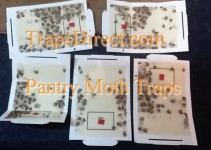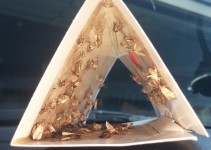Weekly, we receive emails from concerned homeowners trying to identify tiny dirty white worms found in a variety of dry goods.
Alternatively there are inquiries about clumped or matted globs (ok, not so articulate) of _____ (where _____ could be corn meal, flour, pistachios, walnuts, cat food, and on and on). So let’s look into why both inquiries are essentially about the same common pest: Indian Meal Moths
Understanding meal moth eggs and larvae
Let’s study two indian meal moth adults: Mike and Molly meal moth. We will start shortly after Molly and Mike accomplished the goal that they were both born to complete: moth reproduction. At this point Mike heads to the living room to watch tv (is why some meal moths fly around your TV?). Mike will spend his short 7 days as an adult haplessly flying around.
If we watched Molly, after she has mated she sets out on her mission to place the moth eggs in ideal feeding locations. Molly recognizes that within a week when her children hatch, they’ll be hungry. So we watch Molly carefully depositing these tiny eggs in places where moth larvae food is likely to be present. This is no simple task because the average female moth can lay between 25 and 350 eggs in her one and only reproductive cycle. Unlike fish who may lay all their eggs at once, Molly will lay her eggs over the remaining days of her short life. (Adult female meal moths live about 2 weeks, and may spend 7 days placing eggs).
Instinct drives her to placement of the eggs:
- Ideally in an actual food
If there are open containers, or poorly sealed containers of flour, corn meal, pasta, nuts or even dried fruit roll ups our - On packaging
If there are no open sources of food, Molly will lay moth eggs on paper and plastic wrappers. When the moth larvae are born they’ll burrow through even the most secure wrappers to get to the food. - Edges of Cans
When no open food, or packaging locations are left, Molly will start looking for secure places, that might not have food, but will at least afford some protection for her moth children. So rims of canned good are popular - Cracks and crevices
As a last resort Molly will choose tight cracks in shelves and the crevices around the pantry.
How to identify Indianmeal Moth Larvae
Within a week of being laid, indianmeal moth larvae ( Larva Plodia interpunctella ) will form, these resemble tiny dirty white caterpillars (some people will call them worms). Initially you won’t even see them because they are so tiny. But as they grow and begin to feed they’ll reach a length up to 1/2 inch long. As the moth larvae move around in search of food they are constantly spinning a fine thread or web (not so unlike a spider web, but with out any coherent patterns). Over the course of the larval stage this webbing (also called frass ) will form a mat of tunnels, caves and ultimately a cocoon for the larvae to transform into an adult.
For an Indian Meal Moth the majority of life is spent in the Larval stage, which is unfortunate because this is when the infestation causes the most damage to foods. How long the IMM larvae live will vary. In fact it varies wildly based on food sources, temperature and even the length of day.. (It is astounding that an insect in a closed pantry with limited light has a sense of the time of year).
On the low end, the meal larvae can mature in as little as 3 weeks ( During Summer, living directly in flour, in an air conditioned home between 78 – 88 degrees) to as long as 40 weeks (During Winter, on a can of peas, with the heat kept at 68 degrees).
It’s not uncommon for homeowners to think the battle is won because over the winter the moths seem gone.


Interesting information you point out.
I had believed that the moths were looking for food when they were flying around my house. It never occurred to me that they only eat when they are moth larvae.
Imagine if we only ate when we were children!